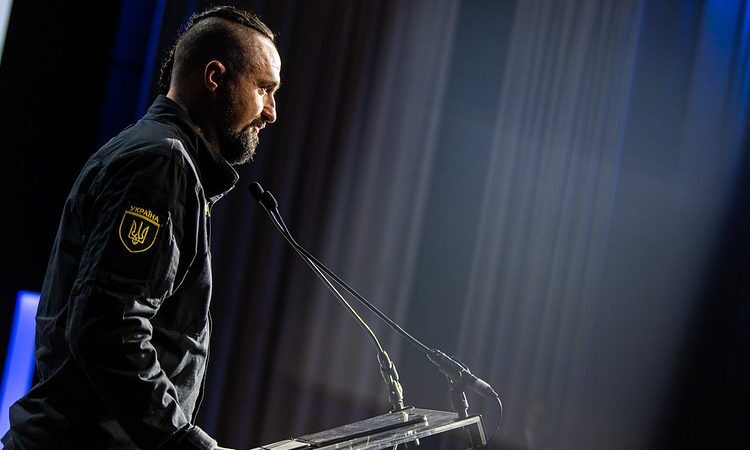
Kyiv is looking for European Union funds to boost support for its domestic arms industry and tap into additional non-contracted capacities, Ukraine’s Minister of Strategic Industries, Oleksandr Kamyshin, told Euractiv.
“[Our] objective is to find more funds to procure from Ukrainian weapons producers (…) we found several initiatives that probably will fly,” Kamyshin said on the sidelines of the EU-Ukraine Industry Forum in Brussels earlier this week.
“In terms of scale and cost, we‘re efficient and capable of producing enough—the only thing that is missing is funding,” he said.
EU funding options
One initiative would be “extending European Peace Facility funds to reimburse member states that procure directly from Ukraine and leave said equipment in Ukraine – it’s fast, it works, it will be great.”
“Second, will be the [use of] windfall profits of frozen Russian assets, up to €3 billion, and making procurement from Ukraine part of this program,” he said.
“When you look at the Ukrainian defence industry, we built up a good machine that can run fast – all we need now is to put sustainable fuel in it, which can only come from windfall profits of Russian frozen assets – without that, we don’t keep running,” Kamishyn added.
EU member states on Wednesday (8 May) struck a political agreement paving the way for using windfall profits from Russian frozen assets to finance the joint purchase of weapons for Ukraine, with the first pay-outs expected as soon as July.
The third initiative would be ” making procurement from Ukrainian producers part of the European Defence Industry Programme (EDIP)”, the minister said.
The European Commission earlier this year proposed that Ukraine become a quasi-member of the EU’s defence industry support scheme, allowing it to access the bloc’s industry and funds, jointly procure military equipment with other EU member states, and VAT-exemptions for joint ownership.
However, negotiations over the programme might stretch into next year.
“Ukraine will be joining the EU and we will bring in the capabilities we have [then] – so this would be joint capabilities of the EU.”
“We don’t want to compete, but we focus on making simple things that work simple and cheap, and we would be complementing European industry and the joint capabilities would be sufficient to deter any aggressor,” Kamyshin said.
Defence match-making
Production and supply for Ukraine’s armed forces has proven difficult more than two years into the war.
The forum brought together 140 firms from 25 countries and aimed to connect European and Ukrainian arms producers, including state-owned Ukroboronprom and private industry.
It follows the bloc’s recent push towards a European Defence Industrial Strategy (EDIS), which aims to ramp up the bloc’s industrial capacities to make Europe war-ready.
“Our industry was here to promote local presence in Ukraine because that also brings value to European defence industry – it is the fastest way to innovate, to make things cheaper and make it in scale,” Kamyshin said.
“We are here not just asking for help; we are here promoting collaboration and co-production – that is the best way we can pay back for all the help we receive and which we are very grateful for, from the EU and all other nations standing with us, for now, more than 800 days.”
To help make collaboration more efficient, there are “plans to open a Ukrainian defence industry innovation office in Kyiv to structure efforts in a proper way,” Kamyshin said.
“We hear a constant interest from European and other Western countries in joint production of defence tech, mainly unmanned systems, be it aerial, naval, land or underwater systems.”
“The best way to make it work is to send your defence industry to Ukraine and start local presence, R&D, assembly, production and service,” he added.
Financing domestic production
Before Russia’s invasion, the country had a large export-oriented arms industry but is currently mainly producing for its own use.
Asked about requests from several Ukrainian companies for export licences to be granted, Kamyshin said this was not currently on the cards.
“For half a year, I’ve been pushing our industry to produce more, also because back then we’ve already seen that we indeed can produce more than we can fund,” Kamyshin said.
“We can fund the industry with what we call the Zbroyari [Armourers] initiative, where the first two countries have already agreed to finance production in Ukraine,” the minister said.
Denmark will spend $28.5 million on procuring weapons made in Ukraine and leave it for Kyiv to use, while Canada is ready to buy drones for $2.1 million.
“Unlocking funds from EPF would be a great move to boost this initiative. Once this works, we don’t need to open the borders to export,” Kamyshin said.
[Edited by Alice Taylor]






